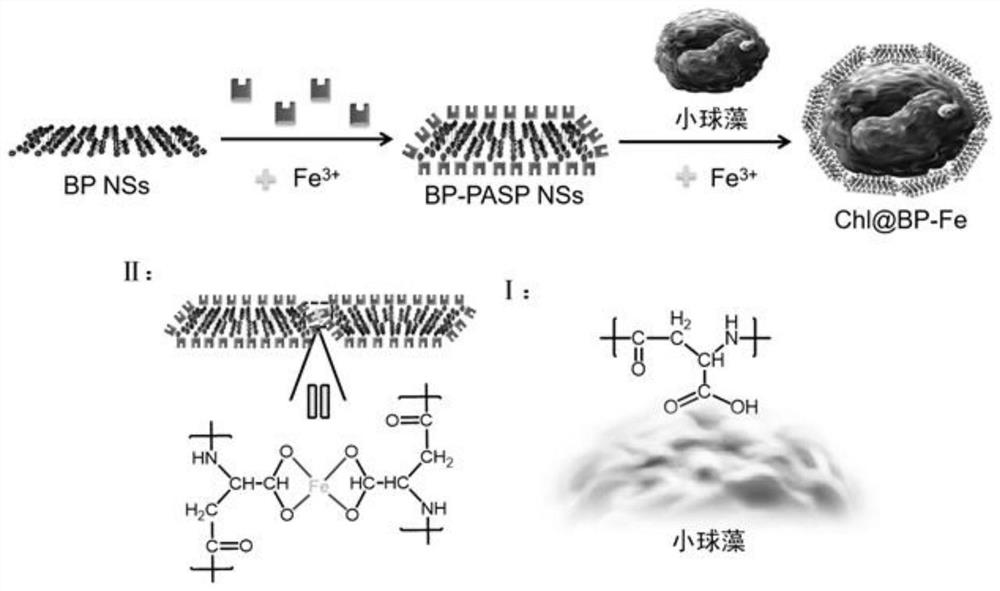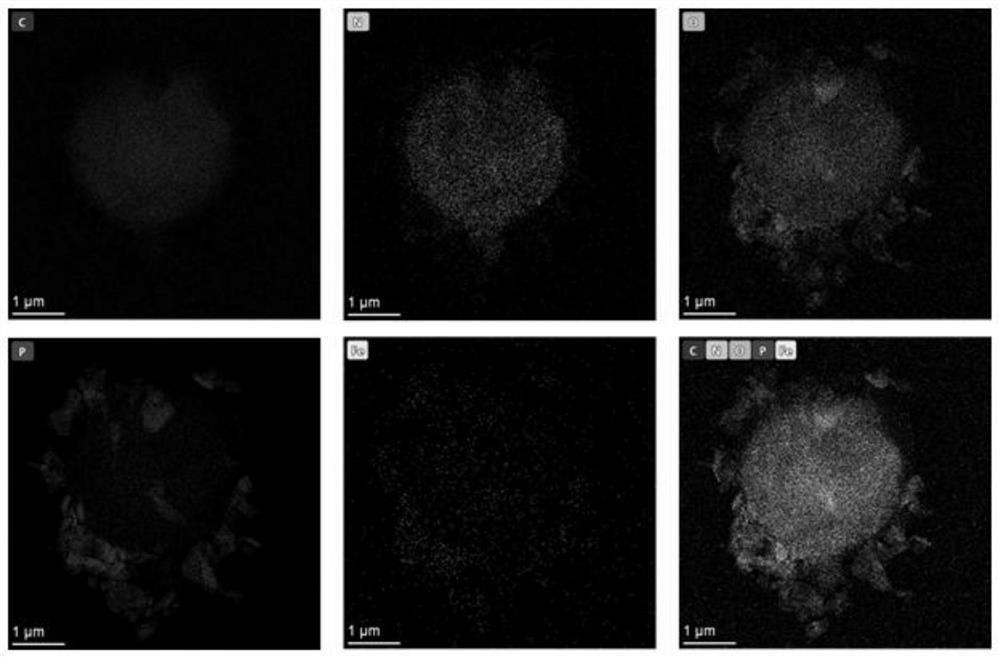Heterojunction functionalized chlorella as well as preparation method and application thereof
A chlorella, functional technology, applied in the field of biomedicine, can solve the problem of limiting the effective production of ROS, and achieve the effect of weakening the antioxidant capacity, increasing the curative effect, and enhancing the effect of immunotherapy
- Summary
- Abstract
- Description
- Claims
- Application Information
AI Technical Summary
Problems solved by technology
Method used
Image
Examples
Embodiment 1
[0052] Example 1 Preparation of Chl@BP-Fe
[0053] S1. Preparation of black phosphorus nanosheets (BPNSs): Grind 40 mg of black phosphorus for 30 min, add 80 mL of N-methylpyrrolidone solvent, ultrasonically crush at a power of 700 W for 8 h, then sonicate in a water bath for 8 h, and centrifuge at a speed of 7000 rpm for 10 min. Supernatant, centrifuge the supernatant at 15000rpm for 15min, take the precipitate, and obtain BPNSs;
[0054] S2. Preparation of black phosphorus nanosheets (BP / PASP-Fe) with surface-modified polyaspartic acid and chelated iron ions: 1 μL of sodium polyaspartate aqueous solution with a mass concentration of 0.4 g / mL and step S1 to obtain 0.2mg of black phosphorus nanosheets were mixed evenly, vortexed for 1min, and then 62.5μL of FeCl with a concentration of 24mmol / L was added 3 The solution was mixed evenly, vortexed for 1 min, washed 3 times with PBS, and centrifuged at 15,000 rpm for 10 min to obtain the "Lego building block" module BP / PASP-Fe; ...
Embodiment 2
[0056] Example 2 Preparation of Chl@BP-Fe
[0057] S1.Preparation of BPNSs: Grind 10 mg of black phosphorus for 45 min, add 100 mL of N-methylpyrrolidone solvent, ultrasonically crush at 600 W for 12 h, then sonicate in a water bath for 12 h, centrifuge at 8000 rpm for 15 min, take the supernatant, and The supernatant was centrifuged at 14000rpm for 20min, and the precipitate was collected to obtain BPNSs;
[0058] S2. Preparation of BP / PASP-Fe: Mix 0.5 μL of an aqueous solution of sodium polyaspartate with a mass concentration of 0.4 g / mL and 0.1 mg of BPNSs obtained in step S1, and then add 57 μL of FeCl with a molar concentration of 22 mmol / L 3 The solution was mixed evenly and vortexed for 1 min, washed 3 times with PBS, and centrifuged at 15,000 rpm for 20 min to obtain the "Lego building blocks" module BP / PASP-Fe;
[0059] S3. Preparation of Chl@BP-Fe: Mix the BP / PASP-Fe obtained in step S2 with the chlorella cell suspension by vortexing for 1 min, wherein the ratio of ...
Embodiment 3
[0060] Example 3 Preparation of Chl@BP-Fe
[0061] S1. Preparation of BPNSs: Grind 200 mg of black phosphorus for 60 min, add 100 mL of N-methylpyrrolidone solvent, ultrasonically break at 650 W for 24 h, then sonicate in a water bath for 24 h, centrifuge at 7500 rpm for 12 min, take the supernatant, and The supernatant was centrifuged at 14800rpm for 18min, and the precipitate was collected to obtain BPNSs;
[0062] S2. Preparation of BP / PASP-Fe: Mix 2 μL of an aqueous solution of sodium polyaspartate with a mass concentration of 0.4 g / mL and 0.5 mg of BPNSs obtained in step S1, and then add 80.3 μL of FeCl with a molar concentration of 20 mmol / L 3 The solution was mixed evenly, vortexed for 1 min, washed 3 times with PBS, and centrifuged at 15,000 rpm for 10 min to obtain the "Lego building block" module BP / PASP-Fe;
[0063]S3. Preparation of Chl@BP-Fe: Mix the BP / PASP-Fe obtained in step S2 with the chlorella cell suspension by vortexing for 1 min, wherein the ratio of bla...
PUM
| Property | Measurement | Unit |
|---|---|---|
| Concentration | aaaaa | aaaaa |
Abstract
Description
Claims
Application Information
 Login to View More
Login to View More - R&D
- Intellectual Property
- Life Sciences
- Materials
- Tech Scout
- Unparalleled Data Quality
- Higher Quality Content
- 60% Fewer Hallucinations
Browse by: Latest US Patents, China's latest patents, Technical Efficacy Thesaurus, Application Domain, Technology Topic, Popular Technical Reports.
© 2025 PatSnap. All rights reserved.Legal|Privacy policy|Modern Slavery Act Transparency Statement|Sitemap|About US| Contact US: help@patsnap.com



